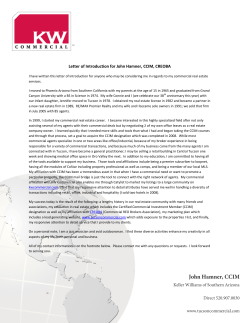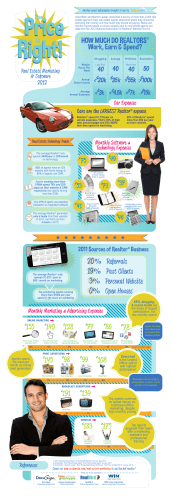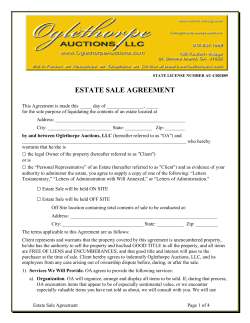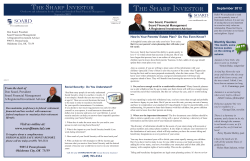
LOW INCOME How to invest on a Three youngsters tell how
EXPERTS' SECRETS TO MAKING BIG PROFITS ON EVERY DEAL NEWCASTLE VS TOOWOOMBA: WHICH IS A BETTER INVESTMENT? October 2013 $9.95 (GST incl.) How to invest on a LOW INCOME Three youngsters tell how they built their property empires on low wages 9 771834 583007 6 4 Hassan Najjarine 6 properties in 6 years, starting aged 19 on just $37,000 a year GAME PLAN How to use property to get out of financial hardship Tony Fleming 8 properties in 4 years, began investing as a 19-year-old deliveryman on $10 an hour RENO SUCCESS How we doubled our money in two weeks Michelle Alkins $1.4m in property deals over 3 years, started saving for a deposit in her teens, first deal at 22 TAX DEDUCTIONS For your investment property (that you are probably missing out on) STRATEGY | MAKE BIG REAL ESTATE PROFITS Real life Contributing market drivers: Infrastructure $35bn coal seam gas project (Origin Energy) – project life of 30 years in the Surat Basin $15bn coal seam gas extraction project (BG Group) in the Surat Basin Estimated 45,000 more jobs to be created across the region Yield variation Rent approximated at $650pw ($325 per side) Rent achieved $680pw ($340 per side) Supply and demand 10,000 construction jobs at its peak; 2000 permanent jobs created by gas exploration in Surat Basin Population growth Current: 155,000 Projected: 2016 = 180,000 2031 = 230,000 Economics Case study 1: Lee and Lucy The deal Toowoomba City Deposit: 13% (approx. $74,000 down on a total purchase price of $542,500) Market timing: At time of purchase: 6.30 – bottom of the market Now: 8.00 – start of recovery Vacancy rate: August 2012: 1.6% August 2013: 1.6% Rental yield: August 2012: 5.9% August 2013: 6.0% Strategy: Off the plan. Possible subdivision after holding. ee and Lucy were interested in doing a build with a L 28 OCTOBER 2013 subdivision, with the option to hold the property to maximise depreciation benefits and capital growth. They chose the duplex so they could buy and hold for about two years and wait for capital growth. Once they had achieved maximum growth they would subdivide and sell. Purchase price: Stamp duty.................................. $4,290 Legal fees......................................... $550 Total ............................................. $4,840 Land .................................. $167,500 Duplex ............................. $375,000 Total ........................................ $542,500 End valuation before subdivision: $570,000, with similar properties in the area selling for $600,000. Capital growth: $22,660–$52,660 yourinvestmentpropertymag.com.au Average growth over 10 years was 10% Demographics 26% of the population were couples with children Large portion of the population worked in mining services or agriculture Positive cash flow after tax $1,319 The build finished just over a month ago. The area is still growing, with lots of new construction around the duplex. Lee and Lucy had one tenant sign on to move in before it was finished. The other tenant moved in a week or two later. Lee and Lucy plan to hold the deal for a few more years until it has reached its potential. They will then subdivide and sell the buildings individually, unless the numbers show that it would be more beneficial to hold one and sell one. STRATEGY | MAKE BIG REAL ESTATE PROFITS big blocks of subdividable land. I’ve seen investors jack the house up, move it over 10 metres, and then subdivide down the middle. Other subdivisions have a driveway down one side to access the large block of land at the back, known as the battle-axe block. Subdivisions can be complicated, so be sure to educate yourself beforehand. I recommend a mentor with experience in subdivision and strata titling. 4 Buying and selling or trading Trading properties, otherwise known as ‘flipping deals’, requires a minimum margin of 20% to be considered profitable. For instance, if with the $250,000 property you chose to add value through time on the market or with renovation, you could potentially raise the value of the property by 20%. This would leave you with a profit of $50,000 and an instant increase to your cash flow. The principles for trading properties are to buy when the market is low, hold as the market rises, and sell when the market reaches the top. The majority of investment property traders tend to be renovators and developers. You would need to learn the skill of renovating or developing for maximum returns. 5 Building for profit The idea is to find a complying development land area that has the potential for better use of the land. Let’s assume we have a block of land worth $150,000 and it’s registered. If we haggle on the property and get a good deal for $120,000, we will achieve an instant $30,000 gain, thanks to the discount. If the cost to build is $1,300 per square metre and the average home in the area is 200 square metres, we would be building for $260,000. Haggle with the builder. Let’s make them do the work for $1,200 per square metre. Instantly we are better than the market at $240,000. Now combine that with the land deal we did, and that’s $360,000 for a home in a market that pays $410,000. Thus we build our way to $50,000 profit. Remember, investing is just a series of small wins over time. There will come a day when you will reminisce about your investments. Don’t look back with any regrets because you didn’t have a go. There is a strategy for all of us, and $50,000 extra per year through property is achievable. OCTOBER 2013 yourinvestmentpropertymag.com.au 29 STRATEGY | MAKE BIG REAL ESTATE PROFITS Real life Julie and Scott were attracted to the deal because of the potential for capital growth in an area that would appeal to families End valuation: $520,000. Contributing market drivers: Case study 2: Scott and Julie The deal Hidden Waters Estate, Fletcher, NSW Deposit: Was 10% (approx. $43,400 down on a total purchase price of $432,400) Market timing: At time of purchase: 8.00 – start of recovery Now: 9.00 – rising market Vacancy rate: October 2011: 1.7% August 2013: 2.1% Rental yield: October 2011: 5.1% August 2013: 5.7% Strategy: Off the plan. Bought at a discount – savings totalled $7,500. Buy and hold. S cott and Julie had been looking within the Hidden Waters Estate in Fletcher, NSW, for some months prior to joining Positive Real Estate. This was because the estate was 30 OCTOBER 2013 close to the Newcastle CBD, and the construction of the new expressway was proceeding. Scott and Julie secured free stamp duty on the land purchase, saving $5,140. Negotiations prior to the deal between Positive Real Estate and Mirvac saved Scott and Julie an additional $7,500 going into the deal. The developer agreed to a $5,000 deposit for the land on exchange of contracts. The couple plan to recycle their deposit for their next purchase. Julie and Scott were attracted to the deal because of the potential for capital growth in an area that would appeal to families due to its good-sized lots and proximity to Newcastle CBD. The property is currently being rented for $520 per week. We are going to use the equity achieved in the property for future investments. Purchase price: Stamp duty..........................................N/A Legal fees..........................................$500 Land .......................................... $190,000 House ....................................... $242,400 Total .......................................... $432,900 yourinvestmentpropertymag.com.au Infrastructure $8bn worth of infrastructure projects commenced in Newcastle region, including: $1.65bn expansion of the F3 motorway to cut Newcastle to Hunter travel time by 28 minutes $1.2bn expansion of Newcastle port $1bn rail upgrade for mining services Supply and demand Demand is increasing while supply is limited as new land allotments are becoming scarce Homeowners and investors are attracted to the area, as proved by property sales in the last 24 months Demographics Working families Fastest-growing sectors of employment are wholesale trade, manufacturing, and healthcare and community services Population growth Over the last 10 years, the population has increased by 8.2% (or 47,611 people) in the Hunter Councils Region (from 580,594 in 1996 to 628,205 in 2006). The region’s population is expected to reach 730,000 by the year 2026.
© Copyright 2026





















